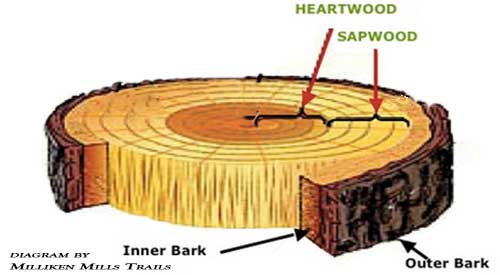
In the Wood Bark or Not debate, this Diagram shows the two key elements of the tree that can effect your Barbecue results. Smokinlicious® only harvests wood from the heartwood of the forest grown tree and recommends that cooking with wood bark not be done.
If you rely on an outside source say a firewood supplier, you may want to rethink cooking with wood bark. Share on X
COOKING WITH WOOD BARK – TO BARK OR NOT?
Is Cooking with Wood Bark Okay or Should I go Bark-Free?
I’ve heard all kinds of reasoning for cooking with wood bark by leaving the bark on: it burns up right away so you don’t need to worry. It’s what gives the flavor to foods. It’s what gives the color to smoked and grilled foods. It is the essence of BBQ!
Well, my intention is to simply provide you with more detail about what is in the bark and then you can decide for yourself if you want to include it in your wood-fired cooking method.
What Is Bark?
There are two types of bark in every tree: living bark which is called phloem and dead bark called rhytidome. For today’s discussion, I am only focusing on the rhytidome or dead bark which is the outer bark layer.
Outer bark’s main purpose is to protect the wood tissues against mechanical damage and preserve the wood tissues from temperature and humidity variations. Bark chemistry is much more complicated than wood tissue chemistry but let’s cover the basics.
Chemistry of Bark
Outer bark has high concentrations of pectin, phenolic compounds, and minerals. Although the exact chemical levels vary by species, the location of the tree, the age of the tree, and growth conditions of the tree let me list some of the common extractives:
ethyl ether – a common laboratory solvent as well as a starter fluid component
dichloromethane – common compound used in paint strippers and degreasers as well as to decaffeinate coffees and teas
calcium oxalate crystals – a calcium salt found in plant materials with a link to kidney stones in humans
Air Pollutant Meter
For many years, university and research facilities around the world have used tree bark as a bioindicator of air pollutant levels as the bark is highly porous, rough, and high in lipids making its surface ideal for absorption. It’s been proven that tree bark soaks up airborne gases and particles. In fact, in my own home state of New York, the Niagara Falls area trees have been noted to have significantly higher levels of Dechlorane. Plus, a flame retardant chemical that is produced by a factory in that city. How much higher? Several thousand times higher!
After many decades of non-regulated chemical use in various products – think pesticides, flame retardants, building material preservatives, etc. – and with the subsequent halting of production of many of these highly toxic chemicals in the 1980s and 90s, research now shows that as those chemicals evaporated, they became airborne particles. Those particles landed and were absorbed by the outer tree bark.
Temperature Fluctuation- Cooking with Wood Bark
My experience with cooking with wood bark by using bark-on woods has been that bark results in temperature control issues. Often, when the bark combusts it does so in variable levels, producing a short burst of elevated temperature. This is likely due in part, to the chemical air pollutant particles that have settled into the outer bark layer. Knowing that bark harbors impurities that the tree is exposed to, I hypothesize that there likely are other particles, likely transferred via air as well as direct contact from the carrier (think animals, humans, etc.), that are absorbed by the tree’s bark.
Change of Taste- Cooking with Wood Bark
Just as lighter fluid can add unpleasant or at the very least a distinct taste difference in foods cooked over product lit with lighter fluid, I caution that some of you will also find an off taste to food when cooking with wood bark is an element of your wood cooking method.
If you are lucky enough to have a source of wood within your own property, that has no neighborly contact with chemical industry, and you feel confident that the bark-on wood is safe, then the choice to cook with it may be easy.
Can you use bark in a smoker?
Cooking with wood bark isn’t at all a good thing! A tree’s bark is its outer skin which protects it from exposure to external elements like mold and harmful chemical air pollutants. This should not be confused with the dark outer layer found on smoked foods- this is not harmful. Tree bark cooking wood is not a healthy choice and could be tainted by even trace amounts of pollutants that have been absorbed over a tree’s life.
We hope you found the article interesting and helpful. Leave a comment or suggestion as we’d love to hear from you so we can bring the information you’re looking for. And don’t forget, follow us and subscribe so you don’t miss anything!
More related reading on why we aren’t a proponent of cooking with wood bark see our smoking & grilling tips & techniques in our blogs directory!
Additional Reading You May Like:
10 Thinks To Consider Before Purchasing Wood For Cooking, Grilling & Smoking
-THE BALANCE OF WOOD LIGNIN IN BARBECUE
-APPLEWOOD – WHY WE DON’T USE IT! – HERE’S WHY
SmokinLicious® products referenced in this blog:
Smoking Wood Chips- Grande® Sapore
Dr. Smoke is very biased on the topic of cooking with wood bark. Bark can add impurities to your wood cooked or smoked food. We are a NO BARK proponent in the “Bark or Not” debate!
